Thanks to modern technologies, runners have many ways to track and measure workouts – the problem is analyzing and using the right data points. Accurate chest heart rate monitors are widely available and almost everyone has a GPS watch and apps like Strava to dissect and share training, so when you’re giving it your all on that last tempo repeat with snot coming out of your nose, how do you measure effectiveness and progress? Are you using your mile pace, your rated perceived exertion (RPE), or heart rate?
In my experience competing as an elite athlete and working as an endurance coach with trail, road, and FKT runners, it’s clear that each metric has its own benefits and pitfalls which make them a better or less useful choice for certain types of runners over others. Many athletes are confused by the volume of data available and unsure of which data point to trust, so in this article I will provide a brief description of the main metrics that exist and offer my perspective on how to use this data as as a runner–because nobody has time to be looking at the wrong info.
Running Workouts Explained

The scientific community agrees that in order for an athlete to train optimally, intention is necessary. This means that when you train hard, you go hard, and when you train easy, you go easy. It sounds simple, but a common training flaw among many athletes is to train at a moderate effort all the time: the easy days are too hard, and the hard efforts lack sufficient intensity and rest.
In the early 2,000s, Dr. Stephen Seiler and other well-versed researchers introduced the “80/20 rule” for endurance training. This concept was developed after observing elite athletes across different disciplines complete 80% of their workouts at a low intensity and 20% at a moderate-high or high intensity and finding that they progressed more quickly and effectively. When applying this strategy to the general public (recreational athletes), they found similar results.
For the purpose of this article, I will solely focus on the 20% portion of high-intensity work as that tends to be where the gains are seen and metrics are necessary. When working with athletes I primarily use pace and RPE for metrics, while heart rate is a complementary and useful additional data point. Below are the 4 primary categories of high(er)-intensity workouts that I assign:
- Speed workout: Develop running economy and VO2 max. Very intense, 8-25 minutes of time spent at the target pace usually done around a track in intervals.
- Hill workout: Develop running economy, VO2 max and ultra specific muscle strength. Very intense, 8-25 minutes of time spent at the target pace done on a hill or treadmill in intervals.
- Tempo workout: Build lactate threshold. Intense pace 15-30 seconds slower than 5k pace, with 20-40 minutes of time spent at the target pace in a single block or intervals.
- Steady state workout: Build aerobic threshold and develop fat burning metabolic system. Moderate effort, with 30-90 minutes of time spent at the target pace.
How Should I Track My Workout?
GPS watches have revolutionized the game compared to 20 (or even 10) years ago. They are affordable, relatively accurate, and convenient. What should you look for in a watch? To be practical, find a watch that can calculate distance (GPS), heart rate (HR monitor), and elevation. On the higher end, you can find watches that last for days in GPS mode, display maps, connect to music and measure things like power output, temperature and oxygen blood concentration.
Here is my quick buyers guide, but certainly do your own research before pulling the trigger. For most runners, I would stick with the entry level models and only go for higher-end pieces if you need extra long battery life or advanced features:
- Best Ultrarunner Watch: COROS Vertix ($600)
- Best Multi-use Watch: Apple Watch 6 ($379)
- Best Watch with Music Capabilities: Garmin 245 Music ($350)
- Best All-Around Watch: COROS Apex ($350)
- Best Budget Watch: COROS Pace 2 ($200)
- Best Non-GPS Watch: Timex Ironman ($47)
Additionally, if you are looking to train off of heart rate data a chest strap is the only way to get a truly accurate measurement. Make sure that the chest strap is compatible with your running watch or phone.
Can I use my phone?
A phone or a non-GPS watch will get you a long way in tracking your runs. Runners have gone for decades without relying on GPS, heart rate, or other data, so you can get along just fine.
One option is to download a run tracking app and take your phone with you on runs. Strava is a great platform and offers social features to engage with other athletes.
Alternatively you can use a standard chronograph watch for time, like the Timex Ironman listed above, and use a running route creator like MayMyRun to measure distance. However, this is more work than necessary and it’s easier just to run with your phone.
Measuring Workout Intensity

Time
Time is the golden standard for road runners and the achilles heel for trail runners. Using mile pace to measure effort is common practice for track and road runners, including Olympic level coaches. Time can be used for tracking hilly road or trail workouts, however it becomes less effective at accurately gauging intensity.
Time can be measured in three ways:
- A pace: 6 minutes per mile
- A split: 75 seconds per 400 meter interval
- A goal effort: Goal half marathon pace
As a coach, I prescribe workouts with time as the primary measurement. I typically use paces, although I use splits for speed workouts. Time is a very useful measurement of workout intensity because it is an objective number. You can easily compare past and future performances of a similar distance or route.
Despite the challenges of using time for a hilly workout, it can shed light on your performance:
- Time, elevation gain/grade and distance can all be used to compare past and future workouts, especially if they are on the same route.
- The data from these workouts can be very useful to estimate your climbing capabilities on race day.
- Supplementing your pacing data with the RPE scale or heart rate data provides a more comprehensive understanding of your fitness.
- Utilizing the grade adjusted pace (GAP) feature in Strava will translate your uphill or downhill pace to that of flat terrain in an effort to normalize the effort for easier comparison to other workouts.
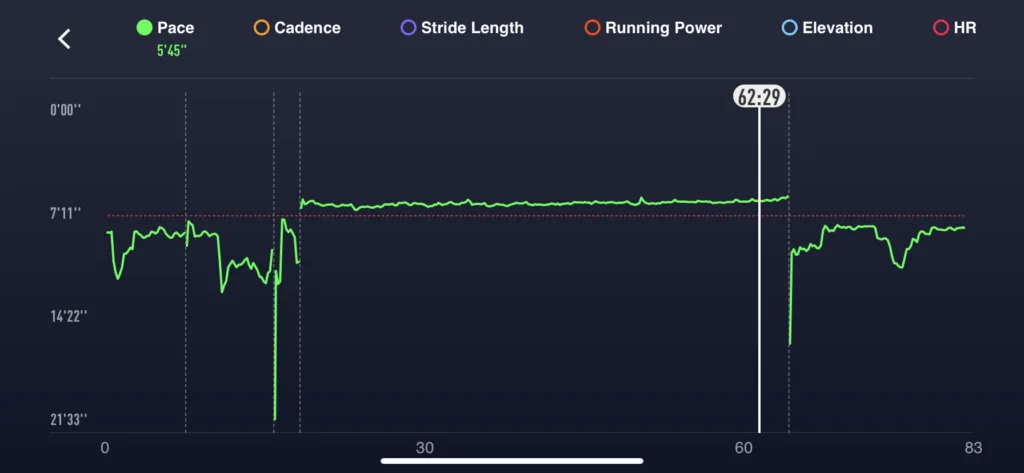
Pros of Using Time
- Ideal for flat speed, tempo and steady state workouts.
- Provides an objective metric and is therefore the best way to measure and compare fitness.
Cons of Using Time
- Difficult to measure workout intensity on trails, hills or mountains.
- Developing time goals is less intuitive for novice or self-coached athletes.
- Poorly set time goals can lead to a lower or higher intended workout intensity for the maximum training benefit.
Rated Perceived Exertion (RPE)
RPE is a self-reported psychological measurement of workout intensity. It is gaining traction amongst ultra runners, but not common practice in the road running community. RPE is rated on a 1-10 scale, one being sedentary and 10 being ‘holy crap, I’m dying, and I didn’t even know I can run this fast.’ RPE has been popularized by coaches like Matt Fitzgerald and Jason Koop.
Here is a simplified scale of how I look at RPE in relation to workout intensity:
- Steady State workout: 6-7 RPE
- Tempo workout: 8 RPE
- Hills or Speed workout: 9-10 RPE
RPE requires a runner to be perceptive of his or her physical state and degradation during a hard effort, which is why I really like using RPE. Runners are forced to use their brains, understanding key feelings, and sensations associated with certain levels of effort. The longer the race distance an athlete is training for, the more useful this skill of cognitive self-perception is.
For more on RPE, you may find this Runner’s World article interesting.
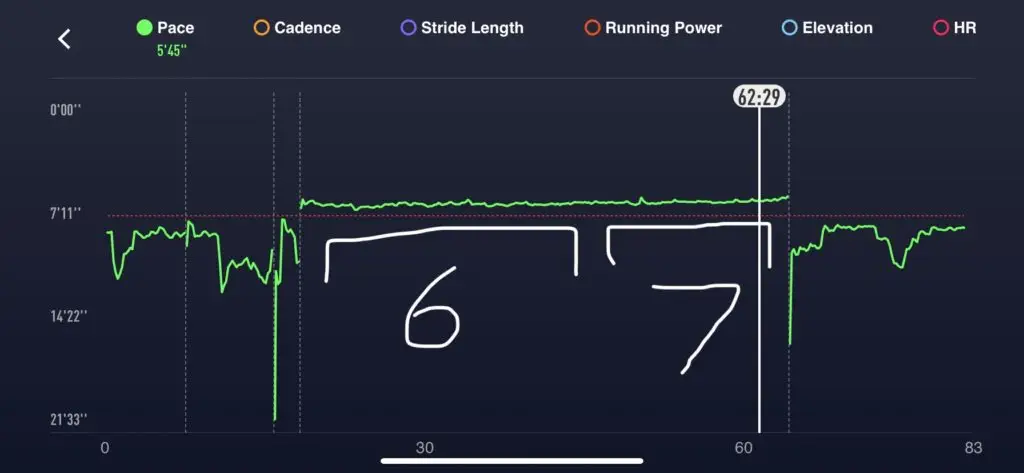
Pros of RPE
- Essential for hill workouts, and useful for workouts with elevation gain/loss.
- Great starting point for less experienced athletes to learn pacing.
- Learn to understand warning signs, like injury & over/undertraining, from your body without relying a technical data.
Cons of using RPE
- Lack of precision. Comparing workout results is not particularly insightful.
- Subjective. Assigning an RPE number is influenced by factors like mood and energy levels.
- Not used as a primary workout metric. Better serves as a complimentary measurement to pace or HR.
Heart Rate
If you meet a triathlete, expect to hear about heart rate and heart rate zones. Heart rate is a popular metric because you can use an empirical metric, how many times your heart rate beats per minute, to accurately predict the type of training stress on your body. Keeping your heart rate in a certain zone, you know if you are going too easy or hard.
Heart rate is most often broken up to 5 different zones. These zones can be based off your lactate threshold or your max heart rate (MHR). For simplicity purposes, we will use max heart rate (calculated by subtracting your age from 220):
- Very light (Zone 1) – 50-60% of MHR
- Light (Zone 2) – 60-70% of MHR
- Moderate (Zone 3) – 70-80% of MHR
- Hard (Zone 4) – 80-90% of MHR
- Very Hard (Zone 5) – 90-100% of MHR
Heart rate is useful because it uses your biofeedback to give pacing guidance and insight. While pace is not a good metric on windy single track trail, heart rate will give a much more accurate reading. Heart rate zones also helps runners define ‘easy’ and ‘hard.’ Since most runners I work with fall into the medium-hard gray zone for most runs, especially easy runs, heart rate zones play a vital role in workout tracking.
That being said, I prefer time over heart rate. Data is skewed by things like humidity, temperature, fatigue, caffeine and central governors theory. Additionally, I’ve seen too much wonky heart rate data from GPS watches to reliably trust them.
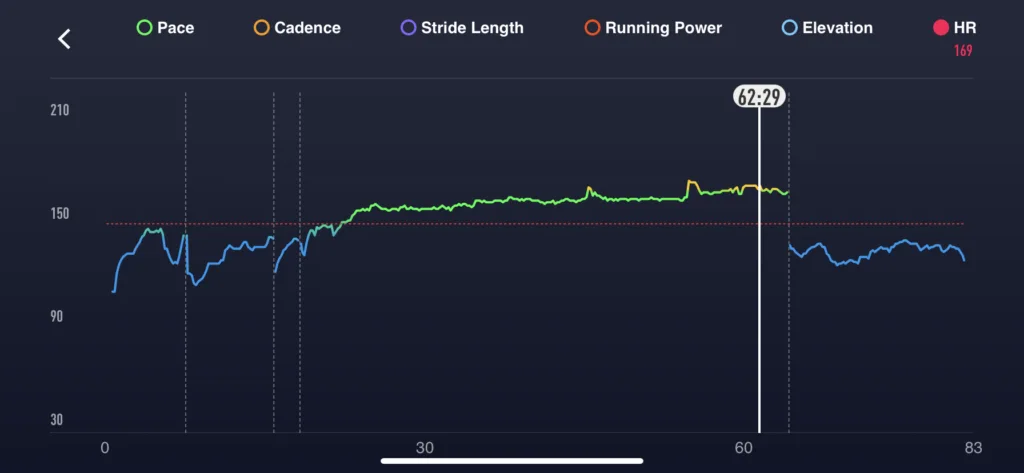
Pros of Heart Rate
- Great measurement for steady state, tempos and long runs, particularly if they are hilly or on windy trails.
- Prevents runners from the trap of running easy runs ‘too hard’ or hard runs ‘too easy.’
- Uses biofeedback as a metric, providing more personalized guidance and data.
Cons of using Heart Rate
- Heart rate is affected by many external factors, skewing workout intensity or HR zones.
- Terrible for speed or interval workouts, as heart rate takes a few minutes to adjust to workout intensity.
- If you are going to rely on heart rate data, get a chest strap for accurate measurement.
Power
Lastly, using power as a metric for intensity is a new and exciting development. Only in the last few years have power meters, like Stryd and COROS, become available for the mass market. Power has been a standard for cyclists for decades. Power is the rate that you can do work over time, or, when rewritten, force times power.
Power = Force (mass x acceleration) x Velocity (distance / time)
Power is superior to pace when it comes to elevation, because pace ignores elevation change. Power is superior to RPE to measure intensity, because watts is an empirical stat. Power is superior to HR when it comes to accuracy, because heart rate is affected by external conditions and takes a few minutes to adjust to increased work load.
Despite this, power will likely take a while to become a popular metric because runners are required to own accurate tracking hardware, which is new to the market, and not heavily researched in runners.
Sample Workout
Let’s apply what we’ve discussed in this article. Below is the 8-mile steady state workout that I referenced previously. I like to input my stats into Google Docs using a training calendar I have made for myself. Here is the breakdown of my workout:
- 2 mile warmup at 4 RPE
- Form drills and strides
- 8 miles progression steady state run from 6:10 to 5:50 pace
- 1 mile cooldown
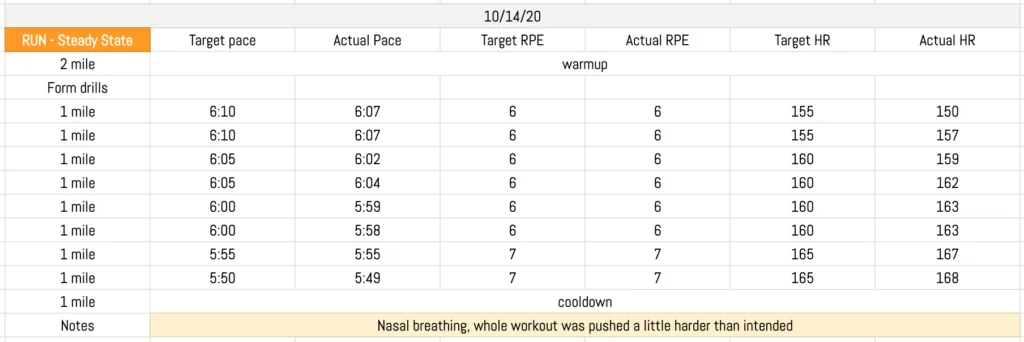
When analyzing the data below in my COROS phone app, you can see I was pretty spot on for my workout. However, I pushed a little harder than I would have liked.
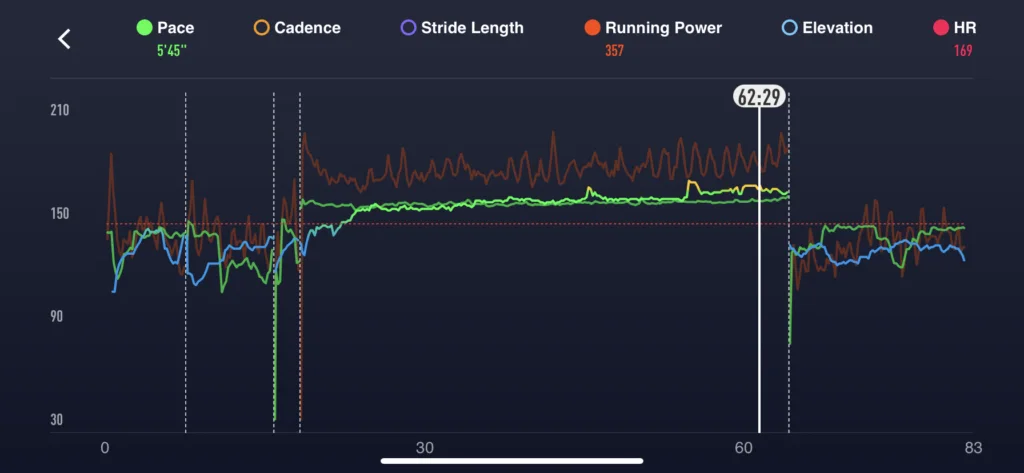
Aside from my effort, a few things stick out:
- Pace: Running on a perfectly flat track surface, pacing is a breeze. Go me! When I went too fast or slow, I was easily able to calibrate my pace to hit an acceptable time.
- RPE: My RPE data adds additional color to my pace data. My perceived effort increased at the end of the workout from a 6 to a 7. This is partially due to an increased pace (~10 sec faster per mile) but can also be attributed to fatigue. This tells me that my last few miles pushed me just outside of my aerobic threshold, and I would have a hard time holding this effort for another hour.
- Heart rate: My heart rate didn’t rise to match my effort until a few minutes into my workout, which is why I don’t like to gauge effort off of HR. Additionally, my heart rate spiked twice during the workout. As I was running on a flat track, I’m guessing that my HR monitor took incorrect data points, probably mistaking my running cadence with my heart rate.
- Power: Since this is a very consistent effort on a flat surface, power is all over the place. Power data should generally match pace. While I like the power feature on my watch, the technology isn’t quite there for me to want to rely on it.
Final Thoughts
Clearly, I like using pace as a measurement for workout intensity. I believe it is the best available metric to assign clear and precise workout times and track progress on relatively flat and consistent terrain. That being said, there is no ‘silver bullet,’ which is what makes training and coaching an art and a science. For the most complete picture of your training and progression as an athlete, multiple metrics can and should be tracked and used.
So, how do you track your workout intensity? How to you measure and track improvements over time?
Leave comments below. I’m excited to hear your thoughts!
This post contains affiliate links. I earn a small commission on sales via these links at no additional cost to you. If you'd like to support me, please purchase products through the affiliate links. Thanks!



